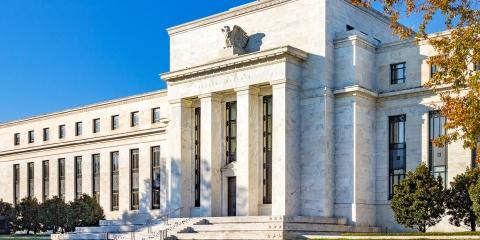January Fed Meeting Throws Cold Water on March
In this article we review:
- The Federal Reserve’s January meeting and why we believe the Fed is less likely to begin cutting rates at its March meeting
- Why we believe the language in the Fed’s statement and post-meeting commentary supports our current forecast of four quarter-point rate cuts during 2H 2024
- Our take on the January employment report and how that and other economic data could impact the Fed’s timing on future rate cuts
- Reiteration of our current federal funds rate target range year-end forecast of 4.25–4.50%
As expected, the Federal Reserve left the target range on the fed funds rate unchanged at 5.25–5.50% as it concluded its January 31 meeting. However, revised wording within the Fed’s statement and post-meeting commentary by Chair Jay Powell seemed to contradict market perceptions of a rate cut as early as the upcoming March meeting.
Taking this background into account, we believe the following points are important for investors:
- The Fed’s statement featured many changes. The Fed ushered in the new year with an atypical amount of statement revisions from its previous December version. These included verbiage on the economy’s recent strength, striking an entire paragraph on “tighter financial and credit conditions,” and language citing that the committee’s risks to achieving its dual mandate (employment and inflation), “are moving into better balance.”
- In our view, two changes were most notable. The first was the deletion of the Fed’s standard tightening cycle language, “in determining the extent of any additional policy firming,” which we view as a formal admission rate hikes have concluded. In turn, this deletion was then tempered by newly added wording, “The Committee does not expect it will be appropriate to reduce the target range until it has gained greater confidence that inflation is moving substantially toward 2 percent,” which we interpret to mean a March rate cut is less likely than recent market expectations had deemed it to be.
- Directly casting doubt on a March rate cut. During the post-meeting press conference, Chair Powell specifically addressed the prospects of reducing the fed funds target range at the March meeting by commenting on the need to see more evidence that inflation is easing before "dialing back the restrictive level," and that at this recently completed meeting there had been "no proposal to cut rates." More directly, he also stated, "(March is) probably not the most likely case or what we would call a base case" for a potential reduction.
- We maintain our forecast of four quarter-point rate cuts in 2H 2024 and a year-end fed funds rate target range of 4.25–4.50%. Prior to the meeting we were not expecting a March rate cut and believed the Fed will need to see more evidence of mitigating inflation and some economic slowing. While market expectations since the meeting have quickly shifted to May regarding the first rate cut in a new easing cycle, we still lean toward June in large part because that meeting will also include the Fed’s Summary of Economic Projections, featuring its participants’ assessment of appropriate monetary policy, aka the “dot plot” of expected future fed funds rate levels.
- Recent economic data further supports no policy action in March. With 353,000 new jobs added to the economy, close to twice consensus estimates, the January nonfarms payrolls report released shortly after the Fed’s meeting displayed impressively high growth along with an unchanged unemployment rate of 3.7%. Wage growth was also higher than anticipated at an annualized rate of 4.5%. Combined with early tracking of strong gross domestic product growth through the first month of the year, the current economic momentum increases the likelihood the Fed will not cut rates until the summer months.
In conclusion, when considering the statement and post-meeting commentary of the Fed’s January meeting and recent economic data, we reiterate our forecast of four quarter-point rate cuts in 2H 2024 likely taking place between June and December and concluding the year with a fed funds rate target range of 4.25–4.50%.
Investments are subject to market risk, including the loss of principal. Asset classes or investment strategies described may not be suitable for all investors.
Past performance does not guarantee future results. Indexes are unmanaged and an investor cannot invest directly in an index.
Equities are subject to market risk meaning that stock prices in general may decline over short or extended periods of time.
Fixed income investing is subject to credit rate risk, interest rate risk, and inflation risk. Credit risk is the risk that the issuer of a bond won’t meet their payments. Inflation risk is the risk that inflation could outpace a bond’s interest income. Interest rate risk is the risk that fluctuations in interest rates will affect the price of a bond. Investing in floating rate loans may be subject to greater volatility and increased risks.
Growth stocks typically are particularly sensitive to market movements and may involve larger price swings because their market prices tend to reflect future expectations. Growth stocks as a group may be out of favor and underperform the overall equity market for a long period of time, for example, while the market favors “value” stocks. Value investing carries the risk that the market will not recognize a security’s intrinsic value for a long time or that an undervalued stock is actually appropriately priced.
Investments in global/international markets involve risks not associated with U.S. markets, such as currency fluctuations, adverse social and political developments, and the relatively small size and lesser liquidity of some markets. These risks may be greater in emerging markets.
The information included in this document should not be construed as investment advice or a recommendation for the purchase or sale of any security. This material contains general information only on investment matters; it should not be considered as a comprehensive statement on any matter and should not be relied upon as such. The information does not take into account any investor’s investment objectives, particular needs, or financial situation. The value of any investment may fluctuate. This information has been developed by Transamerica Asset Management, Inc. and may incorporate third-party data, text, images, and other content to be deemed reliable.
Comments and general market-related projections are based on information available at the time of writing and believed to be accurate; are for informational purposes only, are not intended as individual or specific advice, may not represent the opinions of the entire firm, and may not be relied upon for future investing. Investors are advised to consult with their investment professional about their specific financial needs and goals before making any investment decisions.
The 10-Year U.S. Treasury bond is a U.S. Treasury debt obligation that has a maturity of 10 years.
S&P 500® Index: An unmanaged index of 500 common stocks primarily traded on the New York Stock Exchange, weighted by market capitalization.
Transamerica Asset Management, Inc., (TAM) is an SEC-registered investment adviser that provides asset management, fund administration, and shareholder services for institutional and retail clients. The funds advised and sponsored by TAM include Transamerica Funds and Transamerica Series Trust. Transamerica Funds and Transamerica Series Trust are distributed by Transamerica Capital, Inc., (TCI), member FINRA. TAM is an indirect wholly owned subsidiary of Aegon Ltd., an international life insurance, pension, and asset management company.



